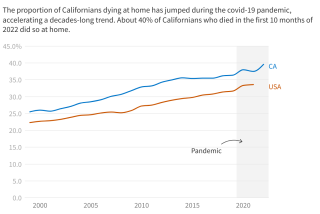The promise and pitfalls of palliative care
What if a new medication for severely ill patients had no role in curing them but made them feel much better despite being sick? Let’s say this elixir were found to decrease the pain and nausea of cancer patients, improve the sleep and energy of heart failure patients, prolong the lives of people with kidney failure, drive down healthcare expenditures and ease the burdens of caregivers?
Those are the promises of a fledgling medical specialty called palliative care — not a new drug but a new way of treating patients who are living, often for years, with acute or chronic Illnesses that are life-threatening.
If palliative care were a pill, government regulators would very likely approve it for the U.S. market. Federal healthcare insurance programs would quickly agree to pay physicians and hospitals for treating patients with the new therapy. And patients would make it a blockbuster drug in no time flat.
Yet uncertainties cloud the prospects for palliative care. Among the unanswered questions: Who will pay for these services, where will this new field’s workforce come from, and what is it — cost savings or compassion — that drives this new branch of medicine?
As answers to those questions emerge in the next few years, palliative care could end up on the roadside of medical progress. Or it could become a must-have service for every hospital and physicians’ group claiming to deliver top-quality patient care.
Providing comfort, emotional support and coordination of specialized care used to be the job of the family physician. But few families these days have a longstanding relationship with a single physician, and even fewer doctors have the expertise or time, while trying to cure a very ill patient, to coordinate his care and tend to his physical and psychological distress.
Growing quickly over the last few years, the field of palliative medicine has begun to step into this breach.
Since 2000, the number of hospital-based palliative care programs has more than doubled, according to a report issued late last month by the Center to Advance Palliative Care and the National Palliative Care Research Center, organizations that have been active in supporting the field’s growth. Today, professional teams tasked with ensuring that patients’ symptoms are managed, their medical options are clearly explained and their wishes are respected are available in roughly 63% of the nation’s hospitals.
The discipline, says Dr. Diane E. Meier, who directs the Center to Advance Palliative Care, “is the necessary counterbalance to a highly specialized system of medicine in which many of our patients’ needs are falling through the cracks. Palliative care. Meier adds, “is needed to focus on the whole person in the context of their family — on everything from pain to spiritual needs.”
For Dr. Marwa Kilani, director of palliative care at Providence Holy Cross Hospital in Mission Hills, this new branch of medicine is about adding life to patients’ years, rather than years to their lives.
“I tend to think that I don’t prolong peoples’ lives in the sense that I don’t deliver the curative medicine; I deliver the quality-of-life medicine — and if that does prolong a person’s life, that’s wonderful,” says Kilani, whose team has been operating since 2006 and has seen 500 new patients so far this year. “I discuss what options patients have, and if a patient says, ‘This sounds like the right course for me and my values,’ I’m there to support that.”
Palliative care is designed to be delivered by teams of physicians, nurses, social workers and chaplains. But instead of treating the condition that threatens to shorten a patient’s life, palliative care professionals treat the pain, weakness, worry and decision-making pressure that come with the illness and medicine’s often-aggressive efforts to treat it.
The movement to provide such care has sprung up alongside the nation’s burgeoning hospice care sector. But though hospice and palliative care share many of the same workforce, goals, patients and expertise, there are two key differences:
First, to gain access to palliative care, patients need not have six months or less to live — the current condition under which hospice care is paid for by Medicare and Medicaid.
Second, patients in palliative care get full support if they wish to pursue any and all efforts to cure their disease — whereas to access hospice care, patient and doctor must have agreed that further “curative therapy” will not be pursued.
In other words, “All hospice care is palliative care, but not all palliative care is hospice,” says Dr. Rick Levene, a palliative care specialist at Spectrum Health Care Inc. in West Palm Beach, Fla.
Ideally, a palliative care team would swoop in shortly after a patient’s diagnosis, explaining medical options, ensuring patient and family have a treatment plan, and standing by to manage the stress and discomforts ahead.
In fact, a trial involving newly diagnosed lung cancer patients found that, despite choosing less aggressive treatment of their cancer, patients who got early and continuous palliative care lived about 21/2 months longer, on average, than those who got standard treatment (11.6 months versus 8.9 months).
The same study, published last yearin the New England Journal of Medicine, found that those who got palliative care reported better quality of life and were less depressed. In their final months of life, the palliative care patients were more likely to choose a different path than those who got the usual care: Among those who did not get the palliative services, 54% spent many of their final hours in costly and painful last-ditch efforts to prolong their lives. Fewer palliative care patients underwent such treatment.
“Palliative care helps patients … live as well as they can for as long as they can,” says study lead author Dr. Jennifer S. Temel, an oncology and internal medicine physician at Massachusetts General Hospital. Helping patients decide whether to go to their summer house, to have their families take time off of work or take a long-planned trip, “that’s where palliative care really helped patients,” she adds.
Doing that, it turns out, may also reduce healthcare costs. Informed by clearer explanations of their options, some patients choose to forego aggressive (and expensive) therapies that may make them feel sicker while offering, at best, a little more time.
Patients who are cared for at home by family, friends and nursing help coordinated by palliative care teams leave the hospital earlier. And they are less likely to have medical crises once they’ve gone home. They show up less often in hospitals’ emergency departments and spend less time in the intensive care unit.
Palliative care patients also appear more likely to have made their end-of-life care wishes explicit, so fewer are intubated or resuscitated in their final days by physicians who don’t know their preferences.
The result: If fully integrated into the nation’s hospitals, palliative care could lower the nation’s healthcare expenditures by reducing healthcare usage — to the tune of more than $6 billion a year, according to a 2010 estimate by the Institute of Medicine, which advises the federal government on medical matters.
A 2008 study led by Morrison and Meier found that, compared with hospitals with no palliative care services, those that provided severely ill patients even a single consultation with a palliative care specialist reduced the overall cost of a patient’s stay by roughly $1,700 and saved hundreds more dollars daily in lab and test costs. In cases in which the patient died before leaving the hospital, the cost savings per admission topped $5,000 when palliative care was provided.
Dr. Rick Levene acknowledges that palliative care’s touted cost savings — paired with the fact that the movement has its roots in hospice care — can generate resistance from patients, families and doctors. Some patients, he says, may see palliative care as a stalking horse for hospice or a bid to ration healthcare or improve hospitals’ bottom lines.
“There are some physicians, some patients and families that can’t give up, and the ‘H’ word [hospice] has created some negative connotations with them,” Levene says. Palliative care specialists adamantly support whatever choice a patient makes about treatment, he adds. Still, the community actively discusses whether its motives are sometimes misunderstood — by patients, politicians and even fellow members of the medical profession.
At the first-ever National Palliative Care Summit in Philadelphia in March, many of the field’s foot soldiers swapped stories and strategies aimed at countering this perception problem. Fresh in their minds was the partisan tempest over healthcare reform and how readily charges of “death panels” were embraced by the public.
Some, including the University of Michigan’s Comprehensive Cancer Care Center, chose a semantic fix. The center used to have a palliative care clinic, oncologist Susan Urba told colleagues. But after it became evident that the name was keeping patients away, Urba reported, the hospital changed the clinic’s name to the Symptom Management and Supportive Care program.
“It’s a little bit of a disservice,” Temel says, that palliative care is so often bound to hospice care.
But for now, palliative care professionals have an even tougher problem: Few of the nation’s 90 million Americans living with serious illness even know who they are or what they do.
In a recent survey conducted for the Center for the Advancement of Palliative Care, 92% of Americans said they would likely want palliative care for themselves or a loved one facing severe illness. The same number said it was important that such care be offered to the severely and chronically ill at all hospitals.
But almost as many needed first to be told what palliative care was.







